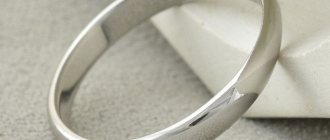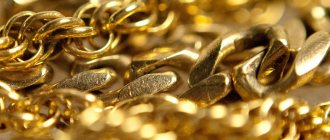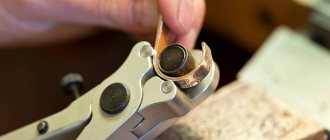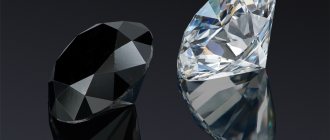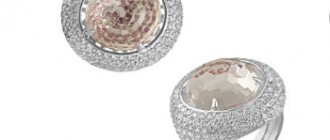Jewelry art is one of the oldest and most widespread types of decorative and applied art. It embodies the inherent human desire for beauty. Jewelry is a special group of goods. Most of them are of purely decorative value. Jewelry products include products made from precious metals, as well as highly artistic products from base metals and alloys, stone, bone in combination with semi-precious stones of natural and artificial origin.
The main consumer properties of jewelry products are their aesthetic properties, and this is their peculiarity. Some of the jewelry (cutlery, cufflinks, etc.) have a specific utilitarian purpose. However, it is not the main criterion when purchasing; the main criterion is the beauty of the products. A certain feature of the consumer properties of jewelry products is also that the service life of jewelry made of precious metals is tens and even hundreds of years.
How is costume jewelry different from jewelry?
Jewelers identify four criteria that help distinguish:
- Price . A designer necklace made of precious metals will be much more expensive than even luxury jewelry.
- Availability . The higher the cost of an accessory, the less accessible it is. Jewelry falls into this category. Costume jewelry is always more affordable than jewelry.
- Design . The fashion industry quickly creates trends. Jewelry models and costume jewelry react differently to innovations. Typically, luxury options are more conservative. Therefore, it is not always possible to find modern specimens. In this regard, jewelry is one step ahead. That's why fashionistas prefer inexpensive options to keep up with trends.
- Quality . This criterion depends on what materials were used at the time of creation. However, the quality of costume jewelry will in any case be slightly lower than that of jewelry.
Tiffany is an American and transnational global brand
- Brand name - Tiffany
- Year the brand was founded: 1837
- Country of origin of the brand: USA
- Type of activity: jewelry production
Perhaps the most famous brand in the world of beauty and jewelry is Tiffany. The long history of this brand started in 1837. Tiffany brand jewelry combines platinum, gold and silver with inserts of especially high-quality cut precious stones. The brand’s colors have also not changed for almost two centuries - gift boxes are turquoise. Silver products of the brand can be purchased at reasonable prices. Designer platinum and diamond accessories reach very high prices.
Jewelry from Tiffany is platinum, gold and silver with precious stones - ideally combining impeccable recognizable style and laconicism. The company does not change its traditions, and today it is these colors that make the brand incredibly recognizable in the world.
Types of jewelry
Costume jewelry is accessories that are made from base metals
Types of jewelry by material
Depending on the material used, there are several groups of decorations.
Elite
Created using gold or silver plating. In some cases, jewelry enamel is used. Elite options are considered an expensive pleasure. Each piece is made in a single copy. Gold-plated jewelry is in particular demand.
Jewelry
They are distinguished by impeccable quality. These can be pearl, amber or coral options. At the time of creation, an enamel coating is used. In terms of external characteristics, this variety is practically in no way inferior to its precious counterparts.
Souvenir
There is always some kind of surprise at the core. For example, a medallion on a chain.
Types of jewelry by purpose
According to the purpose of jewelry, the following types are distinguished:
- Everyday . These pieces are comfortable to wear every day.
- Office . Performed in a discreet style. Many consider these options classic. For example, carnations, a neat brooch or a thin chain with a pendant.
- Evening . These are bright and massive specimens that always catch the eye. They go perfectly with formal and sophisticated outfits.
- Wedding . Such options are impeccable. It is expressed in everything: quality, design, performance and style. This is not surprising, because all attention is focused on the bride.
Page 12 of 21
Jewelry products
Jewelry products are products made from precious metals and precious stones, intended for wearing or interior decoration and having high aesthetic properties. The raw materials for the manufacture of jewelry are: precious metals; their alloys; precious, semi-precious and artificial stones; glass; Ivory; plastics. Most precious metals are highly ductile, soft, and bend easily and therefore cannot be used in their pure form for making jewelry. Alloys are used instead. For jewelry, simple alloys consisting of gold, silver and copper are most often used. The gold content in an alloy of precious metals is determined by the sample, which indicates the gold content in 1 kg of the alloy. For example, 1 kg of 576 gold alloy contains 576 g of gold and, accordingly, 424 g of other precious metals. There are products of low and high standard. The former are characterized by increased hardness and strength, and therefore are more durable. Wedding rings are made from such alloys. Under the influence of time, gold alloys oxidize, become coated and darken. High-grade gold is used primarily for the production of works of art that are not intended for constant and long-term wear. For the production of domestic jewelry, gold of 375, 500 (low standards), 585 and 750 (higher) standards is used. Among the precious metals and alloys used for the production of jewelry, the most valuable are: gold is characterized by high chemical resistance, soluble only in a mixture of hydrochloric and nitric acids, mercury, alkali cyanide; alloys of gold with other precious metals - an alloy of gold with silver, an alloy of gold with copper (has a reddish tint, a hard but viscous consistency), an alloy of gold with palladium (soft and malleable), an alloy of gold with platinum (characterized by increased elasticity and temperature melting); silver - like gold, is considered a noble metal, which also has bactericidal properties, it is a soft and ductile metal, therefore it is most often used in alloys with copper, gold and other metals; alloys of silver and other precious metals are divided into low-grade alloys (750, 800, 830, 875) and high-grade alloys (925, 960 and higher). The former, under the influence of hydrogen sulfide, become covered with a dark coating, which determines their low quality and limited range; Platinum alloys and palladium alloys are used quite rarely in the jewelry industry due to their high cost. Palladium alloys are most often found no higher than 850 fineness. There are alloys of platinum with silver and gold, palladium and radium, alloys of platinum with ruthenium and radium.
Depending on the value and scope of use, precious, semi-precious or ornamental stones are distinguished. Gemstones used in the jewelry industry include diamonds, diamonds (cut diamonds), sapphires, rubies, pearls, emeralds, topazes, turquoise, amethysts, garnets, tourmalines, opals, aquamarines, alexandrites, carnelian, rock crystal and etc. The group of semi-precious or ornamental stones includes malachite, jasper, cat's and eagle's eyes, marble, coral, amber, lapis lazuli, anhydride, chalcedony, agate, jade, etc. According to the method of production, precious, semi-precious and ornamental stones are classified into natural, synthetic and artificial stones. Natural ones are extracted from rocks (rock crystal) or the bowels of the earth. Synthetic and artificial stones are specially grown or obtained chemically. The assortment of this group of stones is represented by turquoise, sapphire, cubic zirconia, citrine, corundum, and garnet. The technological process of jewelry production can be divided into several stages: obtaining blanks - for their manufacture, you first need to obtain the necessary metal alloys (melting). The resulting alloys in ingots are then given ductility by forging. After this, the softened ingots are subjected to rolling or rolling to obtain the required thickness and profile of the product. To make jewelry such as chains and bracelets, precious metals are drawn to create fine threads of gold or silver. There are several ways to shape blanks for jewelry - lost wax casting, frilling of parts (weaving), soldering, stamping, etc. To make chains, various types of weaving are used: fancy, tape, anchor, armor, twisted and Venetian; processing of jewelry stones - cutting, grinding; securing inserts of jewelry stones into products - the stones are secured in the frame.
The classification of the assortment of jewelry is made according to such criteria as the type of materials used as raw materials, purpose and types of jewelry. Depending on the materials used as raw materials, jewelry is made from: precious metals (gold, platinum, silver, palladium products); base metals; jewelry non-metallic mineral and organic raw materials; natural and synthetic gemstones. In turn, jewelry made of gold and silver is divided into: products without jewelry stones; diamond jewelry; products with precious stones and pearls; products with natural semi-precious stones; products with synthetic stones; products with amber. Jewelry by purpose is classified into decorations for the head, neck, chest and hands; their range is represented by the following types of jewelry: tiaras, hairpins, earrings, necklaces, bracelets, chains, necklaces, pendants, medallions, beads; toiletry items and sets of decorations for toiletry items are represented by powder compacts, mirrors, bottles, cufflinks, tie clips, toiletries and pins; watch accessories – watch chains, bracelets, etc.; smoking accessories - cigarette cases, cigarette holders, cigar cutters, mouthpieces, smoking utensils and match holders; items for table setting and interior decoration. The assortment of these jewelry consists of spoons, forks, knives, napkin holders, salt shakers, pepper shakers, mustard pots, shot glasses, glasses, glasses, decanters, tea and coffee utensils, crystal products, flower vases, sculptures, lamps, wall decorations and other items .
During the examination, the compliance of jewelry with the requirements for the quality of jewelry is revealed: the shape, dimensions, weight and cutting geometry of jewelry inserts must correspond to the samples approved in the regulatory and technical documentation and standards. Jewelry must have a uniform coating, free of chips, cracks and hairiness. The lock of jewelry must be reliable, and the fastening of precious stones must ensure their safety during use. Scratches, dents, traces of tool operation, cracks and burrs visible to the naked eye are not allowed on the products. Jewelry made in Russia must be stamped - an imprint of the hallmark of the state Assay Inspectorate and an imprint of the manufacturer's name. There are separate and combined hallmarks. The combined stamp bears a female head in a kokoshnik, looking to the right, or a five-pointed star with a hammer and sickle inside. These imprints are special marks. The five-pointed star with a hammer and sickle inside is an outdated, but still acceptable option. The combined mark is located in a frame, in which, in addition, the digital mark of the hallmark is indicated. To the left of the identification mark it is indicated in which territorial state inspection the mark was applied (in the form of a letter designation). A split mark is usually affixed to detachable and easily removable jewelry. The identification mark is applied to one detachable part of the certificate, and the sample imprint is applied to the other. With detachable branding, the state inspection code is applied in the form of dots. The manufacturer's name stamp consists of a set of numbers and letters: the first number indicates the year of branding; the letter behind the first number means the code of the state inspectorate that applied the mark; the next two digits contain the coded name of the manufacturer. If the product is imported, it must additionally be stamped with the Russian state hallmark. Jewelry must have a label indicating the name of the product, sample, weight, number of stones, trademark of the manufacturer, and standard number. Gold, platinum and silver products are supplied with sealed labels. Jewelry must be packaged in bags and individual boxes.
<< Previous — Next >>
| Table of contents |
| Merchandising of non-food products |
| DIDACTIC PLAN |
| Consumer properties of non-food products |
| Quality of non-food products |
| Classification and structure of the assortment of non-food products |
| Basics of examination of non-food products |
| Textile goods |
| Knitted goods |
| Sewing goods |
| Shoe products |
| Fur products |
| Jewelry products |
| Dry goods |
| Perfume and cosmetic products |
| Dishes |
| Radio-electronic goods |
| Electrical goods |
| Stationery |
| Construction Products |
| Furniture products |
| Household chemicals |
| All pages |
Types of Jewelry
Making jewelry is a long process.
Only precious metals and stones are used to create accessories.
Therefore, the range amazes with its brightness, beauty and luxury .
The following options are currently available in salons:
- Earrings : studs, studs, cuffs, rings, congos, pendants, clusters and chandeliers.
- Rings : wedding, horoscopic, rings, cocktail.
- Hair accessories : tiaras, veils, kokoshniks, tikkas, headbands, headbands.
- Neck jewelry : chokers, collars, beads, necklaces, necklaces, chains, pendants.
- Bracelets : rings, springy, hinged, closed, open hoops, chains.
Cartier is a famous French jewelry brand
- Brand name: Cartier
- Year the brand was founded: 1837
- Country of origin of the brand: France
- Type of activity: jewelry production
The world's favorite brand, Cartier, was born in France in 1847. What is this company known for? Jewelers were commissioned to make the royal crown, which was used to enthronement King Edward VII. From that moment on, the Cartier jewelry house became the official supplier of jewelry to emperors and kings. Millions of people around the world appreciate the beautiful jewelry of this brand. The range of products produced is diverse.
The company tries to stand out from others, and is well known throughout the world. The precious panther on accessories has turned into a real talisman and symbol of success for French craftsmen. Cartier is known throughout the world for its luxurious jewelry and exceptional gemstones, which sell for millions of dollars year after year.
How to choose jewelry
First of all, you need to pay attention to the cost of the accessory. Under no circumstances should you purchase cheap options . The fact is that such specimens often cause allergies . In addition, cheap models are of low quality. A few days after wearing, they may lose their original appearance.
It is also worth considering your own clothing style. For example, it is best to choose sophisticated and neat products for feminine outfits But if you can’t waste time searching, then you can stick to universal options . As a rule, this is jewelry with a discreet design.
Bvlgari is a popular Italian jewelry house
- Brand name - Bvlgari
- Year the brand was founded: 1884
- Country of origin of the brand: Italy
- Type of activity: jewelry production
Another jewelry brand from sunny Italy has become very famous all over the world. The Bvlgari brand was founded in 1884. The founder of the brand is jeweler Sotirio Bulgari from an old Greek family. Over the past 50 years, Bvlgari has become a very popular brand due to its unusual designs and refined finishes. The main metals that are traditionally used by this jewelry house are: white gold, platinum, yellow gold.
For more than 100 years, Bvlgari has shown limitless creativity in celebrating the living, natural beauty of flowers. The distinctive features of the manufacturer are the spirit of the Italian Renaissance, avant-garde and the use of multi-colored stones. The magnificent silver jewelry with which Bvlgari's history began was in particular demand among customers.
How to choose jewelry
The most important thing when buying jewelry is not to fall for a fake.
They can sell a cheap analogue under the guise of an expensive product. Moreover, its price is the same as that of a real piece of jewelry. It is recommended to pay attention to the special label . It must be secured with an iron seal. The label indicates the price, weight, inserts, metal and manufacturer's name.
Also, do not visit pawn shops. This is where you can most often fall for a fake. It is recommended to refrain from purchasing from little-known online stores. The best option would be popular jewelry stores.
Mikimoto is a Japanese luxury jewelry brand.
- Brand name: Mikimoto
- Year the brand was founded: 1896
- Country of origin of the brand: Japan
- Type of activity: jewelry production
Japan is represented in the TOP of jewelry brands by Mikimoto. The founder of the Japanese brand Mikimoto, Kokichi Mikimoto, was the first to patent a unique method of artificially growing natural pearls in 1896. This is where the history of the famous brand began. The assortment includes both classic strings of pearls and unique pieces.
The jewelers of this global brand were able to harmoniously combine pearls and diamonds in one piece of jewelry, and even encrusted a gemstone into a pearl.
How to distinguish gold from jewelry
There are several ways to check a piece of jewelry. The first thing you should pay attention to is the presence of a sample . It is always indicated on jewelry. However, in some cases it is left on costume jewelry to present it as an authentic product. In order not to make a mistake with your purchase, you need to know all the samples of gold.
It is also worth weighing the product. Analogs are always lighter than jewelry. The fact is that expensive metals are not used for production.
So, costume jewelry and jewelry are products that have several differences. Therefore, before purchasing, you should carefully familiarize yourself with the features of the accessories.
You can learn more by watching the video:
Sapphires
Very beautiful jewelry with sapphires. The stones are usually called royal. In a gold frame they look truly luxurious. Then how to choose a sapphire in jewelry? The main criterion for evaluating a stone is its color and transparency. There is a misconception that sapphires can only be blue. This is wrong. In nature there are stones of 160 shades. Sapphires cannot only be red, since they are then rubies.
When choosing jewelry, you need to evaluate the transparency of the stone. It cannot be ideal, since there must be impurities inside. They can be subtle or very pronounced. Synthetic sapphires have characteristic air bubbles inside.
The stone's twin, cordierite, is found in nature. Both minerals are similar, but differ significantly in cost. There are several ways to identify a fake. It is impossible to leave a scratch on sapphire because it is very durable. Holding it in your hand, you will notice that it remains cool. This indicates that the stone is real. But fakes change temperature very quickly.
Classification by purpose - what the product is used for
In addition to aesthetic ones, the accessories around us also perform utilitarian functions. The following typology, which is also used by our online jewelry store, is based on this principle. From the whole variety of jewelry, decorative items and everyday items, the following groups stand out:
- personal jewelry . As the name implies, these are works designed to highlight a person’s appearance - earrings, beads, pendants and pendants, rings and rings, rosary beads, medallions, etc.;
- things for the toilet . This type includes jewelry boxes, powder compacts, mirrors, and perfume bottles. Some researchers include hairpins, clips (for example, for ties or hats), cufflinks and pins in this category;
—
smoking accessories .
These are items such as pipes, mouthpieces, cigarette cases, ashtrays and similar accessories; - cutlery and crafts for table setting . These include spoons, forks, dishes, cups, decanters, coffee pots, napkin rings and even tea strainers!
- decorations for watches . They were popular in the 20th century, but even today you can see a man wearing a precious watch chain or a jewelry chronometer. And watches, bracelets, pendants and pendants with a clock mechanism are in great demand among ladies;
- souvenirs - coins, badges, medals, magnets;
- decorative elements of weapons - linings on the handles of knives and pistols, hilts, ceremonial scabbards;
— writing sets . They can be presented both as whole sets and as separate accessories - stationery knives, pens, inkwells, paperweights;
- decorative home furnishings - vases, candlesticks, lamps, clocks, panels and paintings, figurines and much more;
- items used for religious rituals - icons, incense, censers, candlesticks, baptismal fonts.
